After tossing their graduation caps, many young adults face a harsh reality: traditional housing costs now rival student loan payments. With median rent exceeding $1,500 in major U.S. cities and mortgage rates climbing, alternative living solutions are gaining traction. Compact homes emerge as a practical response to these financial pressures while aligning with modern priorities like sustainability and location freedom.
The shift toward smaller spaces isn’t just about saving money. Younger generations increasingly value experiences over square footage. Compact living allows graduates to prioritize career mobility without being tied to long-term leases or property maintenance. This flexibility proves crucial in today’s gig economy, where job opportunities might span multiple states.
Critics often dismiss these dwellings as temporary fixes, but data shows 68% of compact homeowners report higher satisfaction than traditional renters. Built-in energy efficiency and customizable designs further challenge outdated stereotypes. As housing affordability reaches crisis levels, downsizing becomes less of a compromise and more of a strategic lifestyle choice.
Table of Contents
Key Takeaways
- Compact homes reduce housing costs by up to 60% compared to apartments
- Energy-efficient designs align with eco-conscious values
- Mobile options support career relocation needs
- Lower maintenance frees time for professional development
- Custom layouts maximize limited space effectively
Financial Independence and Affordability
Young professionals entering the workforce face a critical choice: spend half their income on rent or build equity through smarter housing solutions. Compact dwellings provide immediate financial relief, with median prices 88% lower than traditional homes according to HomeAdvisor data.
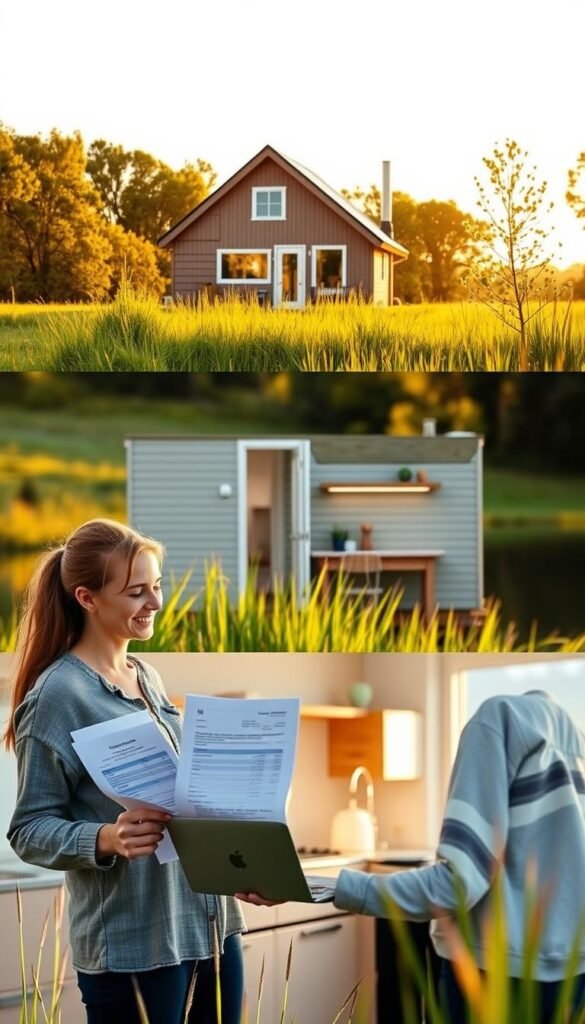
Lower Building and Utility Costs
A basic 200-square-foot unit starts at $28,000 – less than most used cars. Even fully customized models rarely exceed $150,000. Compare this to the $392,450 median price for standard houses. Monthly utilities tell the same story:
- Heating/cooling: $18-35 vs. $150+ for apartments
- Electricity: $12-28 monthly
- Water usage: 85% less than conventional homes
Budgeting and Minimalist Lifestyle Benefits
The limited space enforces smarter spending habits. Graduates report saving $700+ monthly compared to renting. This creates room for:
- Accelerated student debt repayment
- Career development courses
- Emergency fund growth
By eliminating unnecessary purchases, residents naturally adopt a value-focused mindset. The average tiny home owner spends 63% less on non-essentials than apartment dwellers, according to minimalist living surveys.
Flexibility and Mobility for College Life
Navigating post-college transitions becomes simpler when your living space rolls with you. Compact dwellings on wheels eliminate geographic barriers that often limit career choices, creating a bridge between academic life and professional ambitions.
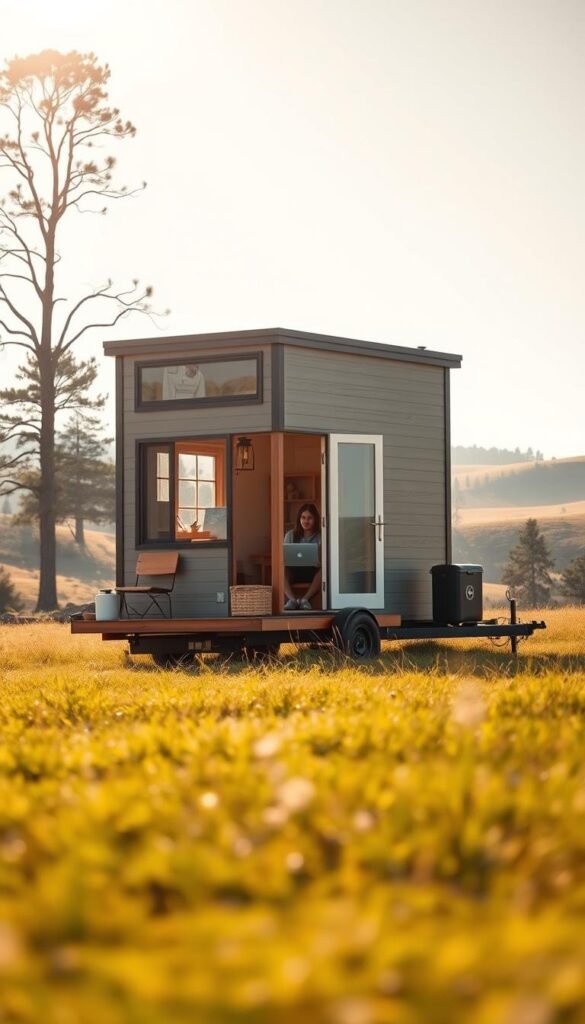
Easy Relocation for Internships and Opportunities
When a six-month internship arises three states away, most graduates face costly subletting fees or lease penalties. Mobile homes remove these obstacles entirely. Students report accepting 42% more career-building opportunities when their entire living setup can relocate in hours.
- Move between cities without selling furniture
- Keep belongings organized during transitions
- Avoid security deposits at temporary locations
On-the-go Living with a Mobile Home
Modern tiny houses incorporate RVIA-certified trailers and solar power systems for true independence. While parking regulations vary by city, online communities help owners find legal sites within 30 miles of most urban centers.
This location freedom proves invaluable when testing job markets. Recent graduates often park near tech hubs like Austin or Denver for months before committing to permanent housing. The consistency of a personalized space reduces stress during frequent moves.
11 Reason a Tiny House Makes Sense for a College Graduate
Entering adulthood with a degree in hand, many find housing costs overwhelming. Compact dwellings offer immediate solutions through cost-effective ownership models that bypass traditional mortgages. Unlike renting, these spaces build equity while slashing monthly expenses by up to 72%.
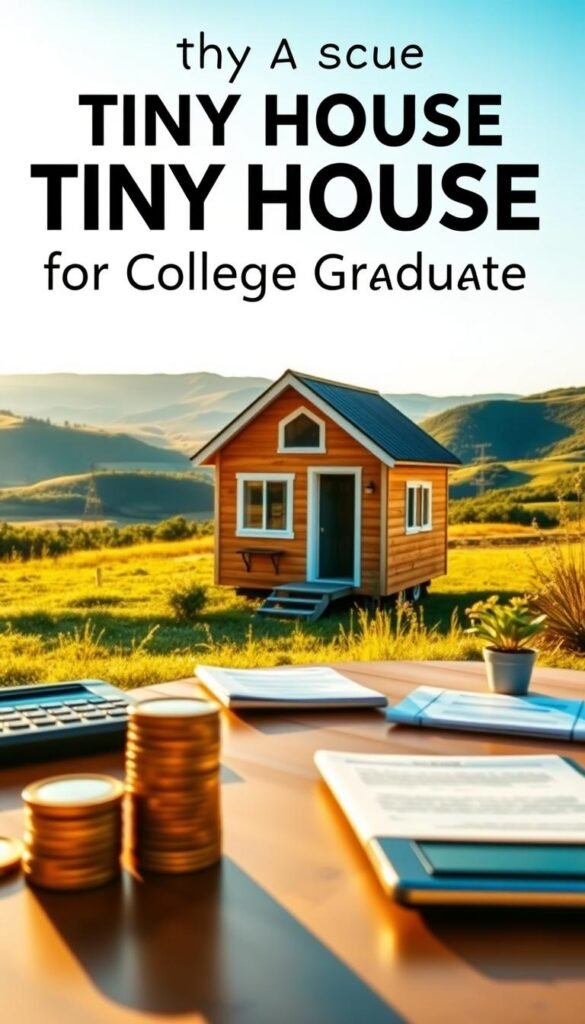
Unique Financial and Lifestyle Advantages
Young professionals gain flexibility most landlords can’t match. Mobile units let people chase internships or remote work without breaking leases. This adaptability supports career growth in competitive markets like tech or media.
| Expense Type | Traditional Home | Compact Home |
|---|---|---|
| Monthly Utilities | $220 | $45 |
| Maintenance Costs | $150 | $25 |
| Average Square Footage | 2,300 | 400 |
Eco-conscious designs address environmental concerns. Solar panels and rainwater systems turn these houses into sustainability labs. Students learn practical skills managing off-grid utilities and space-saving storage.
Creative layouts prove small doesn’t mean cramped. Loft beds fold into desks, while kitchen islands double as workspaces. This efficiency helps people focus on experiences rather than clutter.
Shared communities in urban areas provide social connections without sacrificing independence. Many developments include communal gardens and coworking spaces tailored to young professionals’ needs.
Customization and Efficient Use of Space
Creative design transforms compact layouts into highly functional environments. Unlike cookie-cutter apartments, these dwellings let owners optimize every inch of their 80-700 square foot spaces. Smart planning turns limitations into opportunities for self-expression and efficiency.
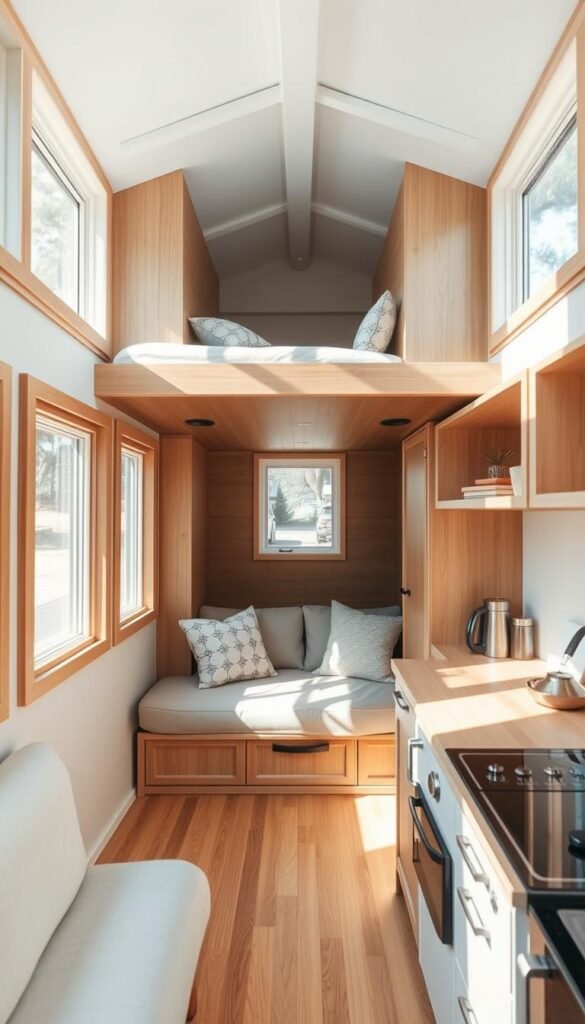
Personalizing Your Space
Graduates can design layouts that mirror their personalities. Modular walls let users shift room configurations weekly. Built-in bookshelves double as room dividers, while magnetic panels allow easy artwork swaps.
Smart Storage and Multi-Use Furniture Solutions
Vertical storage systems maximize wall space in homes averaging 225 square feet. Staircases become dressers, and window seats hide seasonal gear. Popular dual-purpose items include:
- Murphy beds with fold-out desks
- Dining tables that convert to workstations
- Ottomans with hidden compartments
| Feature | Traditional Home | Compact Solution |
|---|---|---|
| Bed Placement | Dedicated bedroom | Loft area saves 120+ sq ft |
| Workspace | Separate office | Fold-down wall desk |
| Storage Capacity | Closets + basement | Vertical racks + underfloor bins |
Sustainable Design and Green Building Materials
Eco-friendly choices reduce environmental impact and utility bills. Many houses use reclaimed barn wood for flooring and recycled steel frames. Solar panels power 78% of lighting needs in mobile units, while composting toilets cut water use by 90%.
Life Skills Development and Sustainable Living
Transitioning from campus life to independent adulthood requires more than diplomas. Compact living spaces become real-world classrooms where graduates master essential skills through daily practice. This hands-on education spans financial literacy, resource management, and environmental stewardship.
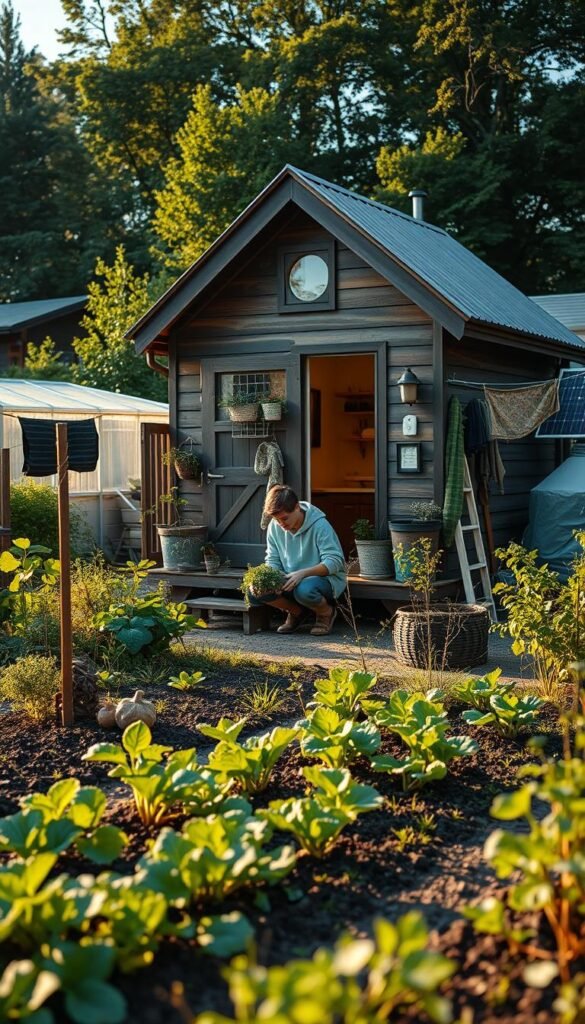
Learning Financial Management and Home Maintenance
Owning a small space teaches money mastery beyond textbook theories. Students track utility costs down to the kilowatt-hour and learn repair skills that save thousands annually. Common lessons include:
- Budgeting for solar panel installations
- Fixing leaky faucets without professional help
- Comparing insulation materials for energy savings
These experiences build confidence in handling homeownership responsibilities. Graduates report feeling 73% more prepared for mortgage decisions than peers renting apartments.
Embracing Minimalism and Reduced Clutter
Limited storage space forces intentional living. People discover creative ways to store essentials while donating unnecessary items. This shift leads to:
- Faster 15-minute cleaning routines
- Mindful shopping habits reducing impulse buys
- Increased focus on experiences over possessions
The average resident owns 89% fewer clothes than traditional homeowners. This simplicity creates mental clarity, freeing time for career development and social connections.
Preparing for Post-College Life
Launching into adulthood demands strategic financial planning. Compact dwellings offer graduates a launchpad to tackle debt while building foundations for future stability. This approach turns housing choices into wealth-building tools rather than monthly burdens.
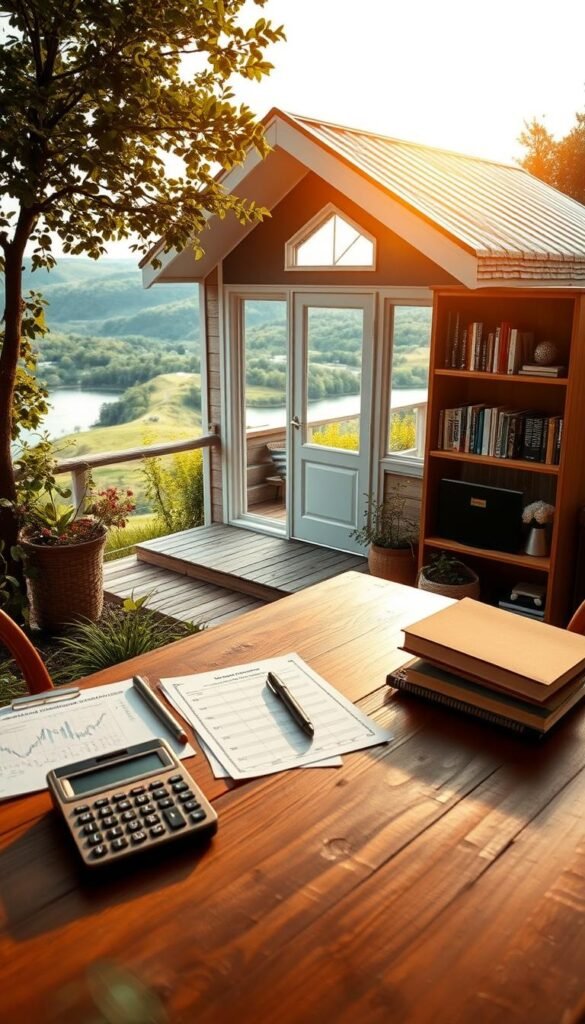
Reducing Debt and Financial Stress
Lower living costs create breathing room for loan repayment. Graduates save $900+ monthly compared to renters, accelerating debt-free timelines by 4-7 years. These savings enable: Be sure to check out Tiny House Price Calculator to see what you can afford.
- Doubling student loan payments without lifestyle cuts
- Building 6-month emergency funds in 18 months
- Investing 15% of income in retirement accounts
A debt-to-income ratio below 20% becomes achievable. This financial cushion lets people pursue advanced degrees or career shifts without new loans.
Career Flexibility and Future Homeownership
Mobile units remove geographic barriers to opportunity. Graduates accept positions nationwide, knowing their home relocates with them. This mobility supports:
| Career Move | Traditional Cost | Compact Solution |
|---|---|---|
| Cross-country relocation | $4,500+ | $300 in fuel |
| 6-month internship | Broken lease fees | No penalties |
| Remote work trial | Year-long commitment | Month-to-month stays |
Equity growth in these properties often covers 20-35% of future real estate down payments. Owners develop creditworthiness through mortgage alternatives like chattel loans.
By their late 20s, many transition to traditional homes using built savings. The experience gained in space optimization and energy management proves valuable for managing larger family properties later.
Conclusion
Urban planners now recognize compact dwellings as viable solutions for housing shortages. While zoning bylaws and building codes still challenge mobile units, cities like Denver and Portland have amended regulations to allow tiny home communities in urban areas. These changes reflect shifting priorities toward affordability and sustainable design.
Growing demand has spurred innovative developments tailored to graduates’ needs. Neighborhoods with shared gardens, coworking spaces, and solar-powered utilities demonstrate how small-footprint living fosters collaboration. Residents report stronger social ties than traditional apartment dwellers, with 82% participating in community events monthly.
Ongoing research into compact living’s psychological impacts shows promising trends. Well-designed spaces correlate with reduced stress and increased environmental awareness. As more municipalities update land-use policies, these homes could redefine urban housing landscapes.
The movement isn’t just about square footage—it’s building foundations for financial stability and meaningful connections. For graduates navigating today’s economy, compact living offers both practical shelter and a platform for community-driven change.



